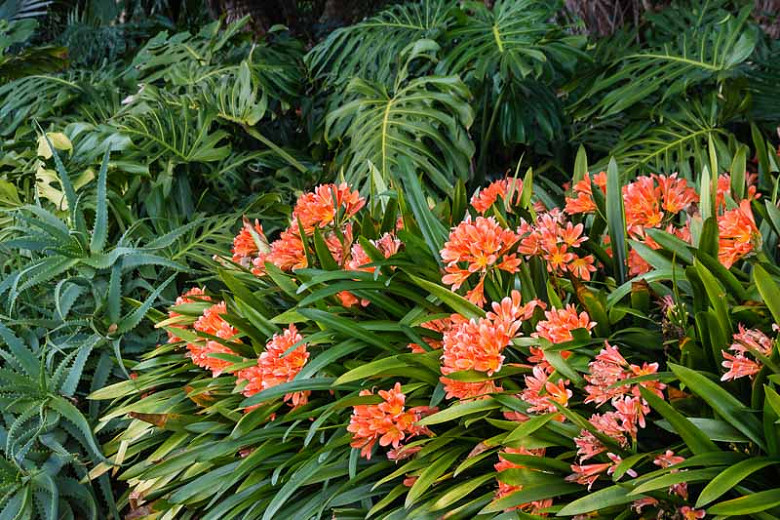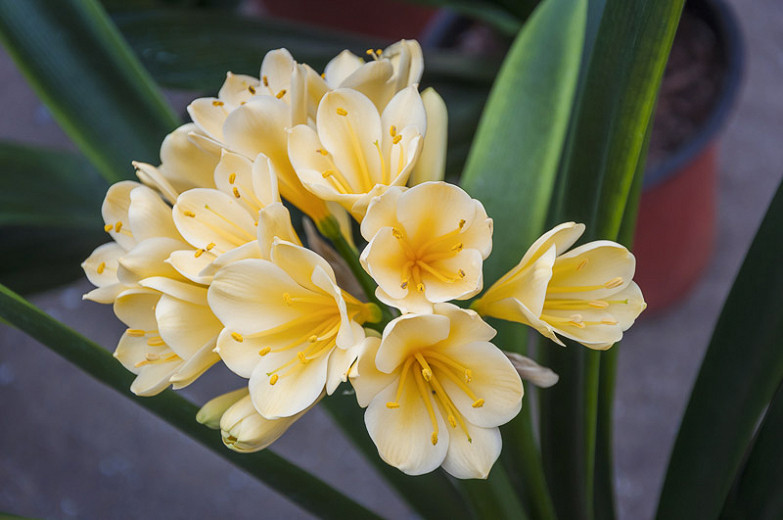Clivia miniata (Natal Lily)
Prized for its brilliant flowers, Clivia miniata (Natal Lily) is an elegant rhizomatous evergreen perennial boasting large clusters of 15-20 funnel-shaped, orange-red flowers from early winter to mid-spring. The blossoms, 2.5 in. long (7 cm), are adorned with contrasting yellow throats. They are borne atop erect, thick stems above the dense foliage clump of lustrous, dark green, strap-shaped leaves, up to 2 ft. long (60 cm). Long-lasting, the flowers are followed by ornamental red berries. When the plant is not in bloom, the lush, virtually blemish-free, evergreen foliage still provides a sculptural presence. Native to South Africa and Swaziland, this gorgeous tropical plant is damaged by freezing temperatures lower than 30°F to 25°F (-1°C to -4°C) and is best in frost-free areas. Natal Lily is a showy and striking addition to beds, borders, or containers and is often grown as a houseplant. Good as cut flowers too!
- Recipient of the prestigious Award of Garden Merit of the Royal Horticultural Society.
- Grows up to 18-24 in. tall (45-60 cm) and 24-36 in. wide (60-90 cm).
- Easily grown in bright filtered light with shade from the hot sun in well-drained soils. Water freely in summer and allow to dry for winter. The soil should be kept just moist until the flower stalk reaches 6 inches (15 cm), then water normally.
- Apply a balanced liquid fertilizer weekly when in growth up to flower bud formation.
- Virtually disease free. Keep an eye out for mealybugs. Root rot, yellow spots on the leaves, or failure to form a flowering stalk may occur if too much water is provided.
- Best flower production when the plant is pot bound, however, it should be repotted every 3-4 years in late winter or early spring. Take care to untangle the roots carefully as Natal Lily resents root disturbance.
- Propagate by seed at 60-70°F (16-21°C) as soon as ripe or by division in late winter or early spring.
- All parts may cause a stomach upset if ingested.
- Toxic to dogs, toxic to cats.
- Native to South Africa and Swaziland.
Requirements
| Hardiness | 9 – 11 |
|---|---|
| Heat Zones | 1 – 11 |
| Climate Zones | 12, 13, 14, 15, 16, 17, 19, 20, 21, 22, 23, 24, H1, H2 |
| Plant Type | Perennials |
| Plant Family | Clivia |
| Exposure | Partial Sun |
| Season of Interest | Spring (Early,Mid,Late)Summer (Early,Mid,Late)FallWinter |
| Height | 1' – 2' (30cm – 60cm) |
| Spread | 2' – 3' (60cm – 90cm) |
| Spacing | 18″ – 24″ (45cm – 60cm) |
| Water Needs | Average |
| Maintenance | Low |
| Soil Type | Chalk, Clay, Loam, Sand |
| Soil pH | Acid, Alkaline, Neutral |
| Soil Drainage | Well-Drained |
| Characteristics | Cut Flowers, Plant of Merit, Showy, Evergreen |
| Garden Uses | Beds and Borders, Patio and Containers |
| Garden Styles | Mediterranean Garden |



